Search Product
Search here for what you are looking for:
Search here for what you are looking for:
Stainless steel wire mesh is a valuable material that requires proper storage to maintain its performance and extend its service life. The corrosion resistance and overall quality of stainless steel wire mesh can be significantly affected by storage conditions. In this article, we will discuss the importance of storing stainless steel wire mesh correctly and provide guidelines for optimal storage.
Chemical Composition and Material Selection:
The corrosion resistance of stainless steel wire mesh is influenced by its chemical elements, such as nickel, chromium, copper, molybdenum, titanium, niobium, and nitrogen. When selecting stainless steel wire mesh, it is crucial to consider the material composition and choose a grade that is suitable for the intended application.

Storage Environment:
In addition to selecting the right material for stainless steel wire mesh, the storage environment also plays a vital role in maintaining its quality. Here are some key considerations for storing stainless steel wire mesh:
Ventilation, Dryness, and Cleanliness: The storage area for stainless steel wire mesh should be well-ventilated to prevent the accumulation of moisture. Dryness is essential to avoid corrosion or rust formation. Additionally, the storage space should be kept clean to prevent dust, dirt, or other contaminants from settling on the mesh.
Protection from Adverse Weather: During adverse weather conditions, protective measures should be taken to shield the stainless steel wire mesh from rain, snow, or excessive humidity. Exposure to moisture can lead to corrosion, compromising the integrity of the mesh.
Proper Packaging: Stainless steel wire mesh should be adequately packaged to protect it from potential damage. The packaging should prevent contact with acids, alkalis, oils, solvents, and other substances that can potentially corrode or stain the mesh.
Sorting and Rotation: When storing stainless steel wire mesh, it is advisable to sort the products and place them in rolls. Additionally, the rolls should be flipped or rotated every quarter to avoid deformation or permanent set caused by extended periods of pressure in the same position.
Temperature and Humidity Control: Ideally, the storage warehouse should maintain a moderate temperature between 25 degrees Celsius and below 50 degrees Celsius. Controlling the humidity within appropriate levels helps prevent moisture-related issues that can affect the stainless steel wire mesh.
Prompt Problem Resolution: If any issues or problems are detected at any stage of storage, they should be addressed promptly. This includes addressing any signs of corrosion, damage, or environmental factors that may compromise the integrity of the stainless steel wire mesh.

By following these guidelines and ensuring proper storage conditions, the service life of stainless steel wire mesh can be significantly extended. Well-maintained storage environments contribute to the preservation of the mesh's corrosion resistance, structural integrity, and overall performance, resulting in a reliable and long-lasting product for customers.
In conclusion, proper storage of stainless steel wire mesh is essential to maintain its quality and maximize its lifespan. By considering the material selection, ventilation, dryness, cleanliness, protection from adverse weather, proper packaging, sorting and rotation, temperature and humidity control, and prompt problem resolution, users can ensure that their stainless steel wire mesh remains in optimal condition and delivers reliable performance throughout its service life.